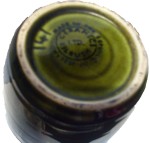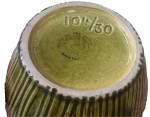Kilrush Ceramics on the West coast of Ireland is a long way from the former West Germany so the puzzle for many years has been why do many of their vases mirror those produced in Germany.
The similarities between ceramics produced by Kulrush and West German companies are striking. The shapes and glazes are similar and in some cases identical and the bases have form numbers and sizes moulded in the same style as their German counterparts. Most of the Kilrush vases have a circular ink stamp on the base reading “KILRUSH CERAMICS LTD MADE IN THE REPUPLIC OF IRELAND”. Some have a gold oval stickers which read “CERAMICS KILRUSH MADE IN THE IRISH REPUBLIC”. All are made using a white clay.
- Kilrush Ceramic Vase – 141
- Kilrush Ceramic 141 Base
- Kilrush Ceramic Vase 104-30
- Kilrush Ceramic 104-30 Base
Until very recently all that was known was that Kilrush (apparently its trading name was, Celtic Ceramics) was that it was founded by a group of Irish and German businessmen in 1961, taken over by Rosenthal in 1976 and closing in 1983. An array of West German companies were rumoured to have been involved; ES Keramik (suggested in the BBC Homes & Antiques Magazine), ES Keramik, Carstens, Dumler & Breiden and U Keramik amongst others. What was also unclear was whether items were manufactured in Ireland by Kilrush or whether they were re-labeling items made in Germany.
PotsandPots endeavoured to find out what they could and have been recording all the Kilrush items sold on ebay.co.uk and ebay.com for the last 12 months. The hope was to find a vase with a Kilrush stamp and the corresponding vase with the same number with definitive West German company identification (sticker, markings etc). 20 different West German-esque forms were identified. All the form numbers were between 109 and 143 with one exception (1008/18). This perhaps suggests that the range of vases produced was not particularly large, perhaps starting at around ~50 shapes. Later discoveries, demonstrating the West German connection was relatively short lived, lends support to the probability of a limited range of West German style shapes.
A vase with the same form number and definitive Kilrush and West German markings was not found. The evidence however was suggesting the link was to U Keramik. Glazes were similar between the two companies and some of the forms had striking resemblances. Form 1008 by Kilrush was found to be relatively prevalent in Germany and had always been attributed to U Keramik but we were not able to find a form with an original sticker to confirm the identification. Other forms appeared to be identical between the two companies but bore different form numbers, for example Kilrush form 123 and U Keramik form 455.
Then I stumbled upon a recent discovery made by Russell (bistoboy on the pottery and glass forum) who had been in contact with a Sales Manager at U Keramik and had been able to complete our understanding of the Kilrush/West German association. The links started in the late 1950s when County Clare searched for overseas investors in the region. This would have formed part of the larger Irish economic policy at the time which looked to attract foreign investment through a programme for economic expansion. This included the repeal of legislation limiting foreign ownership of new firms.
U Keramik were incentivised to open an Irish factory by the Irish economic policy including:
- Favorable loans from the Irish government for the first 10 years;
- No or very low income tax for the first 5 years;
- Financial support for trainees; and
- The possibility to export to UK and the Common Wealth at favorouble import duties and taxes
Kilrush ceramics was established by three U Keramik brothers, Mr. Kuechenmeister (a businessman from Hanover, living in Ireland), Mr. O’Solivan (solicitor from Ennis, Ireland) and Mr. O’Driscall (former fighter for freedom in Ireland) alongside some smaller shareholders from the area.
During 1960 approximately 100 future Kilrush Ceramics staff travelled to Ransbach-Baumbach, home of U Keramik and a number of other West German pottery companies (Jasba, Jopeko, Fohr etc). They were trained at the U Keramic factory by the 250 German employees. The knowledge transfer continued further with two of U Keramik’s best designers and their technical director subsequently spending several months in Kilrush providing continued support and expertise.
High quality technical machinery was purchased for the Kilrush Ceramics factory from Marktredwitz, an industrial center specializing in ceramic machinery, located in Bavaria close to the Czech boarder. The moulds and castings to be used by Kilrush were all produced in the U Keramik factory in Ransbach-Baumbach and along with the machinery they were transported via boat from Koblenz to Kilrush.
Despite the incentives provided by Irish economic policy and the investment of U Keramik the venture failed after just two years. Thomas Porcelain, a German ceramics company, who incidentally originated from the same Bavarian town where the Kilrush machinery had been manufactured, purchased the company. This change is ownership is likely to the reason for the teapot and tea services which Kilrush produced as this was the mainstay of Thomas porcelain. Kilrush subsequently passed into the control of Rosenthal in 1976, who themselves owned Thomas Porcelain. In 1983 Kilrush Ceramics ceased production.
This post forms part of a series of blogs, Seeing Double, which looks at examples of different West German pottery companies producing very similar forms or decors (you can see the others by clicking here).




